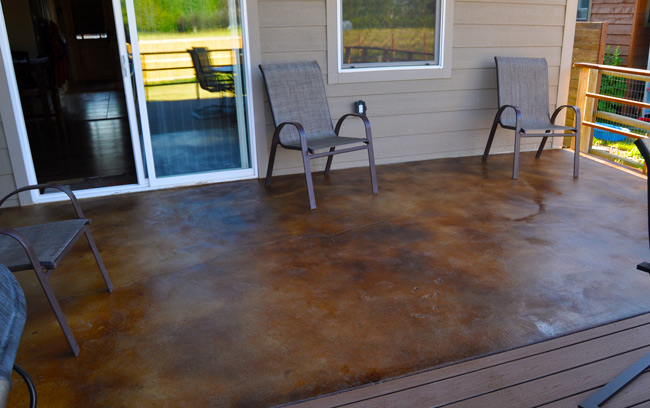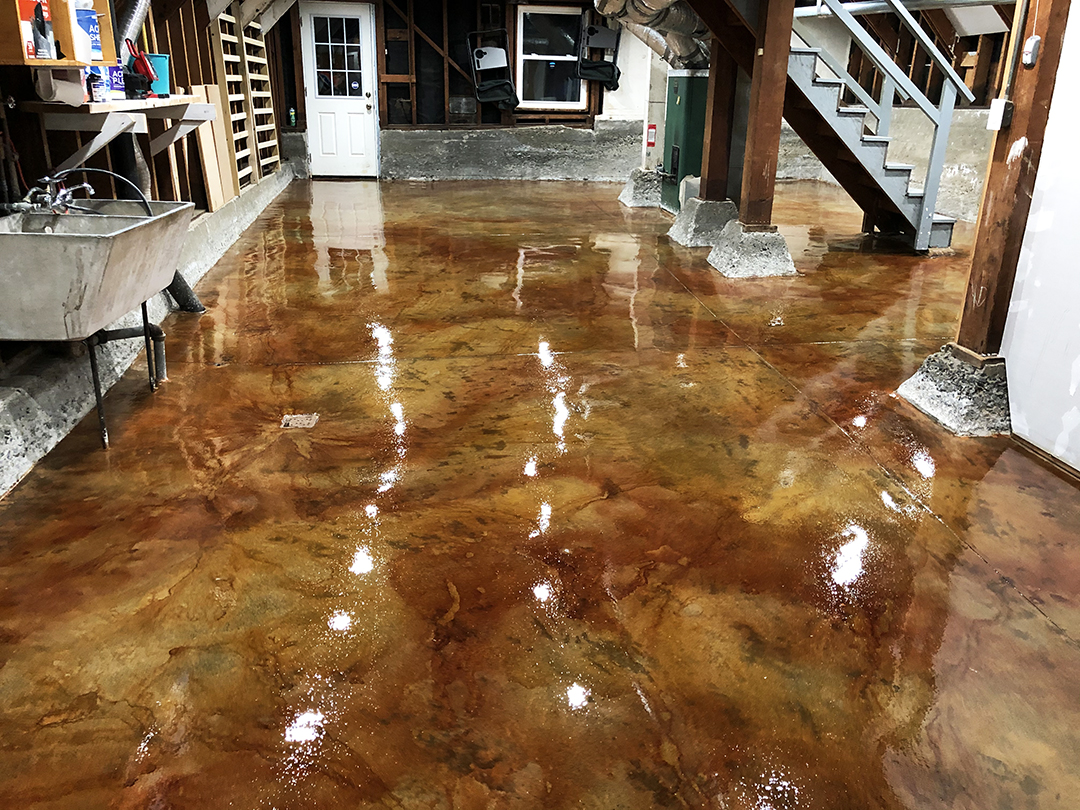Questions to ask your stained concrete company
Everything About Stained Concrete: A Comprehensive Guide to Its Advantages and Applications
Stained concrete has actually become a preferred selection for both residential and commercial spaces. Its ability to combine visual allure with usefulness makes it an interesting option. Various staining strategies supply a variety of colors and coatings, permitting personalization. The advantages expand past look. Comprehending its applications and maintenance needs is essential for anybody considering this versatile product. The subtleties of stained concrete invite further expedition.
What Is Stained Concrete?

Staining can be applied to different surfaces, including floors, driveways, and outdoor patios, making it a functional choice for both interior and outside areas. The treatment can achieve a series of looks, from earthy tones to vibrant, modern-day layouts. Unlike paint, stained concrete maintains its look in time, as it comes to be an important component of the concrete itself. In general, stained concrete offers as an efficient approach for changing regular concrete right into aesthetically striking surfaces.
Advantages of Stained Concrete
Stained concrete offers significant advantages, specifically in aesthetic charm and toughness - stained concrete floors. Its vibrant shades and special patterns improve the visual beauty of any type of space, making it a prominent option for both residential and business applications. Furthermore, the longevity of stained concrete warranties that it remains a practical financial investment in time, resisting deterioration
Aesthetic Allure
One of one of the most compelling benefits of using stained concrete is its impressive aesthetic allure. Stained concrete offers an unique and flexible appearance that can match numerous style styles, from modern-day to rustic. The infusion of vivid colors and detailed patterns allows home owners and designers to produce customized surface areas that can enhance the general atmosphere of an area. Unlike conventional floor covering choices, stained concrete can mimic the look of natural rock or refined marble, providing a high end appearance without the associated expenses. In addition, the glossy surface choices can mirror light, further brightening insides. This flexibility makes stained concrete a favored option for both household and commercial applications, where visual effect is paramount.
Resilience and Longevity
The remarkable aesthetic qualities of stained concrete are matched by its impressive toughness and longevity - stained concrete company. Stained concrete surface areas are immune to damage, making them suitable for high-traffic areas both inside your home and outdoors. Their robust nature indicates they can stand up to rough weather conditions, including extreme temperatures, rain, and UV exposure, without considerable deterioration. Additionally, stained concrete needs very little upkeep contrasted to various other floor covering choices, as it does not need regular sealing or refinishing. This durability not only decreases replacement costs but also adds to a sustainable building approach. Overall, stained concrete gives an enduring service that incorporates visual appeal with sensible benefits, ensuring its worth with time
Various Sorts Of Staining Techniques
Different discoloration methods can substantially influence the aesthetic qualities of concrete surface areas. The three primary approaches include acid staining, which responds chemically with the concrete, water-based staining, which supplies a wider range of shades, and overlay staining choices that offer a fresh surface area. Each method has distinct characteristics and applications that accommodate different layout preferences and project demands.
Acid Staining Technique
How can home owners transform simple concrete surfaces right into visually striking functions? One effective technique is acid staining, a prominent strategy that improves the all-natural charm of concrete. This procedure involves using a solution of water, hydrochloric acid, and metal salts to the concrete surface area. As the acid reacts with the lime existing in the concrete, it creates abundant, variegated shades that resemble marble or rock. Acid discoloration is known for its resilience and resistance to fading, making it a long-lasting option for both interior and outdoor applications. It is important to keep in mind that the outcomes can differ based on the original concrete color and structure. Correct application and sealing are important for accomplishing the wanted aesthetic and longevity
Water-Based Discoloration Method
A preferred alternative to acid staining, the water-based staining method uses home owners a versatile method to boost concrete surface areas. This method utilizes water-soluble dyes and pigments, permitting a large array of colors and finishes. Unlike acid stains, water-based spots can be used to unsealed concrete and supply a simpler clean-up procedure. The outcomes can accomplish an extra consistent look and can be layered to create distinct impacts. In addition, water-based stains are normally much less poisonous and produce fewer unstable organic substances (VOCs), making them a lot more eco pleasant. Home owners might value the capacity to tailor their concrete surfaces with different shades, allowing for innovative expression while preserving toughness and durability in their floor covering options.
Overlay Staining Options
Many overlay staining alternatives exist for property owners looking to renew their concrete surfaces. One preferred choice is acid discoloration, which reacts chemically with the concrete to create abundant, variegated colors. An additional option is water-based discoloration, offering a wider shade palette and less complicated application. Additionally, concrete overlays can be incorporated with stencils for complex designs, improving looks. For a more distinctive coating, property owners might consider utilizing stamped overlays that resemble natural materials like stone or floor tile. Each technique offers one-of-a-kind advantages, from sturdiness to modification, enabling for an individualized touch. Ultimately, the choice of overlay discoloration relies on the desired look and the condition of the existing concrete, making certain a refreshed and appealing surface area.
Applications of Stained Concrete
Stained concrete deals a functional solution for various applications, improving both visual charm and capability. This product is generally used in property, business, and commercial setups, making it a popular selection amongst architects and designers. In homes, stained concrete can serve as elegant floor covering or exterior patio areas, providing an innovative appearance while continuing to be resilient.
In commercial areas, such as stores and dining establishments, stained concrete adds to a modern-day ambiance and can withstand hefty foot traffic. Furthermore, stained concrete is progressively used in public spaces like parks and walkways, where its capacity to imitate natural stone or various other materials includes visual interest.
Stained concrete is excellent for pool decks and driveways, supplying see this a slip-resistant surface that is easy to keep. In general, the flexibility of stained concrete makes it suitable for countless environments, satisfying diverse tastes and demands.
Upkeep and Take Care Of Stained Concrete
Proper upkeep guarantees the long life and beauty of stained concrete surface areas. Routine cleaning is vital; using a light detergent and water with a soft-bristle brush aids remove dust and crud without damaging the coating. It is suggested to stay clear of extreme chemicals that can strip away the tarnish or sealer.
Sealing stained concrete is vital for protection against moisture, spots, and wear. A top notch sealant should be reapplied each to three years, depending upon the website traffic and exposure the surface area withstands. Additionally, attending to spills quickly will prevent staining and discoloration.

Price Factors To Consider for Stained Concrete Projects
When preparing a stained concrete project, spending plan considerations play a vital function in figuring out the general cost. The expenses connected with stained concrete recommended you read can vary substantially based upon numerous aspects. First, the dimension of the location to be stained straight affects product and labor costs. Larger spaces will normally call for even more sources. Second, the sort of discolor selected-- acid-based or water-based-- can affect prices, with acid spots usually being more costly. Additionally, the complexity of the layout, consisting of patterns or numerous colors, can boost labor costs. Preparation job, such as cleaning and grinding the concrete surface area, includes to the initial expenditures. The selection in between DIY installation and hiring a professional specialist will certainly better affect the budget plan. Recognizing these factors makes it possible for homeowners to make informed economic choices about their stained concrete projects, guaranteeing they accomplish the desired aesthetic within their financial methods.
Tips for Picking the Right Stained Concrete for Your Room
Picking the ideal stained concrete for a particular area entails careful contemplation of various variables past just spending plan. First, one must review the desired use the area. High-traffic areas may require more sturdy finishes, while attractive applications can focus on looks.
The color combination is one more crucial aspect; the picked shades should integrate with existing design and illumination. It's also crucial to take into account the surface texture, as smooth surfaces can boost class, while textured options may ensure safety in wet areas.
Local climate and ecological problems play a significant role in the durability and upkeep of stained concrete, affecting the choice of sealers and surfaces.
Consulting with professionals can supply beneficial insights tailored to particular demands, ensuring the selection of the ideal stained concrete that aligns with both performance and design.
Regularly Asked Questions
Can Stained Concrete Be Applied Over Existing Floor Covering?
Stained concrete can undoubtedly be used over existing flooring, gave the surface is stable and navigate to this website appropriately prepared. This approach enables a visual upgrade without the demand for full elimination of the original floor covering products.
Just How Lengthy Does Stained Concrete Last?
Stained concrete can last for decades when correctly preserved. Factors such as web traffic, environmental problems, and application methods significantly affect its long life, with several setups staying vibrant and undamaged for 10 to three decades.
Is Stained Concrete Slippery When Damp?
Stained concrete can be slippery when wet, as the surface might develop a smooth surface. Making use of non-slip additives or distinctive coatings can mitigate this issue, improving safety without jeopardizing the aesthetic allure of the concrete.
Can I Tarnish Concrete Myself, or Should I Work with a Professional?
The choice to tarnish concrete personally or employ a professional hinges on ability level and project intricacy. While DIY discoloration can conserve money, experts ensure excellent results, particularly for detailed layouts or huge surface areas.
What Color styles Are Readily Available for Stained Concrete?
The selection of shades available for stained concrete consists of earthy tones like browns and tans, lively tones such as reds and blues, and softer shades like pastels. This scheme enables innovative, individualized design options.